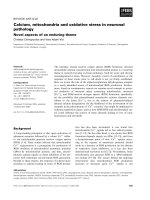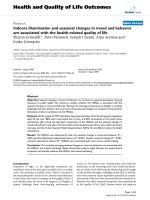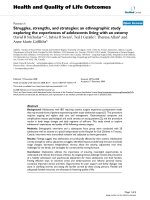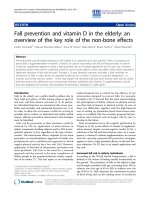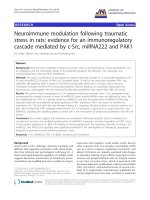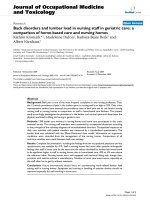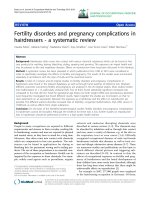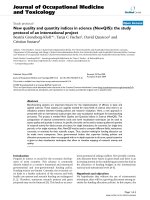báo cáo hóa học: " Brain inflammation and oxidative stress in a transgenic mouse model of Alzheimer-like brain amyloidosis" pptx
Bạn đang xem bản rút gọn của tài liệu. Xem và tải ngay bản đầy đủ của tài liệu tại đây (678.13 KB, 9 trang )
BioMed Central
Page 1 of 9
(page number not for citation purposes)
Journal of Neuroinflammation
Open Access
Research
Brain inflammation and oxidative stress in a transgenic mouse
model of Alzheimer-like brain amyloidosis
Yuemang Yao
1
, Cinzia Chinnici
1
, Hanguan Tang
1
, John Q Trojanowski
2,3
,
Virginia MY Lee
2,3
and Domenico Praticò*
1
Address:
1
Center for Experimental Therapeutics and Department of Pharmacology; University of Pennsylvania, School of Medicine, Philadelphia,
PA 19104 USA,
2
Center for Neurodegenerative Disease Research; University of Pennsylvania, School of Medicine, Philadelphia, PA 19104 USA
and
3
Institute on Aging; University of Pennsylvania, School of Medicine, Philadelphia, PA 19104 USA
Email: Yuemang Yao - ; Cinzia Chinnici - ; Hanguan Tang - ;
John Q Trojanowski - ; Virginia MY Lee - ;
Domenico Praticò* -
* Corresponding author
Abstract
Background: An increasing body of evidence implicates both brain inflammation and oxidative
stress in the pathogenesis of Alzheimer's disease (AD). The relevance of their interaction in vivo,
however, is unknown. Previously, we have shown that separate pharmacological targeting of these
two components results in amelioration of the amyloidogenic phenotype of a transgenic mouse
model of AD-like brain amyloidosis (Tg2576).
Methods: In the present study, we investigated the therapeutic effects of a combination of an anti-
inflammatory agent, indomethacin, and a natural anti-oxidant, vitamin E, in the Tg2576 mice. For
this reason, animals were treated continuously from 8 (prior to Aβ deposition) through 15 (when
Aβ deposits are abundant) months of age.
Results: At the end of the study, these therapeutic interventions suppressed brain inflammatory
and oxidative stress responses in the mice. This effect was accompanied by significant reductions
of soluble and insoluble Aβ1-40 and Aβ1-42 in neocortex and hippocampus, wherein the burden
of Aβ deposits also was significantly decreased.
Conclusions: The results of the present study support the concept that brain oxidative stress and
inflammation coexist in this animal model of AD-like brain amyloidosis, but they represent two
distinct therapeutic targets in the disease pathogenesis. We propose that a combination of anti-
inflammatory and anti-oxidant drugs may be a useful strategy for treating AD.
Introduction
Alzheimer's disease (AD) is the most common, complex
and challenging form of neurodegenerative disease asso-
ciated with dementia in the elderly. Neuropathological
examination of the AD brain shows extensive neuronal
loss, accumulation of fibrillar proteins as extra-cellular
amyloid β (Aβ) plaques, and as neurofibrillary tangles
(NFTs) inside neurons [1]. However, besides these patho-
logical hallmarks, AD brains exhibit clear evidence of
chronic inflammation and oxidative damage [2,3].
Published: 22 October 2004
Journal of Neuroinflammation 2004, 1:21 doi:10.1186/1742-2094-1-21
Received: 22 September 2004
Accepted: 22 October 2004
This article is available from: />© 2004 Yao et al; licensee BioMed Central Ltd.
This is an open-access article distributed under the terms of the Creative Commons Attribution License ( />),
which permits unrestricted use, distribution, and reproduction in any medium, provided the original work is properly cited.
Journal of Neuroinflammation 2004, 1:21 />Page 2 of 9
(page number not for citation purposes)
Currently, data from human studies as well as animal
models strongly support the concept that oxidative imbal-
ance and subsequent oxidative stress are among the earli-
est events in the pathogenesis of AD [4,5]. Thus, an
increase in lipid peroxidation, protein oxidation and DNA
oxidation has been reported not only in AD patients, but
also in subjects with mild cognitive impairment (MCI)
[6,7]. Similarly, immunohistochemical and biochemical
evidence for these signatures of oxidative stress have been
shown in animal models of AD-like brain amyloidosis,
i.e. the Tg2576 transgenic mouse model thereof [8-10].
Chronic neuroinflammation is another constant feature
of AD, and this also is thought to play a significant role in
the onset and progression of AD. Support for this hypoth-
esis comes from epidemiological studies showing that
prolonged use of nonsteroidal anti-inflammatory drugs
(NSAIDs) decreases the risk of developing AD as well as
delaying the onset of this disorder [11], while many medi-
ators of inflammation have been detected in the AD brain
[12]. Further, recent studies in AD mouse models have
shown that chronic treatment with a subset of NSAIDs
(e.g. ibuprofen, flurbiprofen, indomethacin) reduced
brain inflammation and Aβ levels in addition to the dep-
osition of Aβ in brain [13,14]. Despite this evidence, and
the considerable theoretical and therapeutic interest, the
relationship between brain inflammation responses and
oxidative stress has not yet been clearly delineated in AD.
For example, its is possible to consider these two events as
elements of the same response mechanism, or they can be
envisaged as two separate events. Alternatively, they also
could work in concert to contribute synergistically to the
pathogenesis of AD.
In the present study, we examined whether the simultane-
ous administration of an anti-oxidant, vitamin E, with an
anti-inflammatory drug, indomethacin, would exert an
additive anti-amyloidogenic effect in the Tg2576 mouse
model of AD-like Aβ brain amyloidosis, one of the most
extensively studied mouse models of AD [15]. Signifi-
cantly, we found for the first time that coincidental sup-
pression of brain oxidative stress further augments the
anti-amylodogenic effect of indomethacin.
Materials and Methods
Animals
The genotype and phenotype features of the heterozygote
Tg2576 mice that we studied here have been described in
earlier reports on these mice from our group [9]. Mice
were weaned at 4 weeks, kept on a chow diet, and males
were always separated from females for the entire study.
Eight-month-old Tg animals were divided in two groups
(n = 10 each), and randomized to receive placebo, or
simultaneously indomethacin (10 mg/liter) in their
drinking water, and vitamin E (α-tocopherol) in their diet
(2 I.U./mg diet) for seven months before being sacrificed.
The detailed dosing of the animals receiving indometh-
acin or vitamin E alone (at the same concentration used in
the present study) were described in two previously pub-
lished studies which also included data on numerous
non-transgenenic littermate controls of the Tg2576 mice
[16,17]. Fresh drinking water and diet were always
replaced every other day. Preliminary experiments dem-
onstrated that the selected dose of indomethacin sup-
pressed total cylcooxygenase-1 activity in vivo and
significantly reduced brain inflammation [16]. The high
dose of vitamin E was selected based on a previous study,
which indicated that at this concentration it significantly
reduced brain oxidative stress response [17]. During the
study, all mice gained weight regularly, and no significant
difference was detected between the two groups.
Tissue preparation
Animals were anesthetized and euthanized following pro-
cedures recommended by the Panel on Euthanasia of the
American Veterinary Medical Association. They were
always perfused intra-cardially for 30 min with ice-cold
0.9% phosphate buffer saline (PBS), containing EDTA (2
mM/L) and BHT (2 mM/L), pH7.4. Brains were removed
and one hemisphere was fixed by immersion in 4% para-
formaldehyde in 0.1 M PBS (pH7.4) at 4°C overnight,
blocked in the coronal plane, and embedded in paraffin
as previously described for immunohistochemistry
[9,16,17], The other hemisphere was gently rinsed in cold
0.9% PBS, then immediately dissected in three anatomical
regions (total cerebral cortex, hippocampus, and cerebel-
lum) for biochemistry.
Biochemical analysis
Tissue samples were minced and homogenized, and total
lipid extracted with ice-cold Folch solution (chloroform:
methanol; 2:1, vol/vol). Lipids were subjected to base
hydrolysis by adding aqueous 15% KOH and then incu-
bated at 45°C for 1 hr for measurement of total iPF
2α
-VI
by ion chemical ionization gas chromatography/mass
spectrometry assay, as previously described [9,16,17]. In
brief, a known amount of the internal standard is added
to each sample, after solid phase extraction samples are
derivatized and purified by thin layer chromatography,
and finally analyzed. An aliquot of these extracts was
assayed for total levels of PGE
2
and TxB
2
by a standardized
ELISA kit following the manufacturer's instructions (Cay-
man Chem. Com.). Briefly, extracts were diluted with ace-
tate buffer and purified through an affinity column. The
purified samples were evaporated, re-dissolved in the
assay buffer and applied to 96-well plates pre-coated with
goat anti-serum IgG and incubated with PGE
2
or TxB
2
monoclonal antibodies. The plates were rinsed with wash-
ing buffer and developed using Ellman's reagent for 60–
90 min at room temperature with gentle shaking. Specific
Journal of Neuroinflammation 2004, 1:21 />Page 3 of 9
(page number not for citation purposes)
concentrations were determined spectrophotometrically
and expressed as pg/mg tissue.
IL-1β levels were measured by a standardized sandwich
ELISA kit following the manufacturer's instructions
(Endogen Pierce). Briefly, equal amounts of sample were
loaded onto 96-well plate pre-coated with monoclonal
antibody against mouse IL-1β overnight at 4°C. The plates
were rinsed three times with washing buffer and devel-
oped with streptavidin-horseradish peroxidase (HRP)
[13]. Specific concentrations were determined spectro-
photometrically and expressed as pg/mg protein.
Total protein carbonyls in tissue were determined by
using the Zenith PC test kit according to the manufac-
turer's instructions (Zenith Tech.) [18]. Briefly, aliquots of
the tissue homogenates were first reacted with dinitroph-
enylhydrazine (DNP), transferred to a multi-well plate,
incubated with blocking reagent, washed and probed with
anti-DNP-biotin solution. After washing, samples were
incubated with streptavidin-HRP, washed again, and then
developed. After 15 min, the reaction was stopped and
absorbance immediately read at 450 nm. Oxidized pro-
tein standards, internal controls and blanks were always
assayed at the same time and in the same way. All samples
were always determined in triplicate and in a blind
fashion.
Immunoblot analysis
An aliquot of brain homogenates was electrophoresed on
a 10% acrylamide gel under reducing conditions. Protein
were transferred to a polyvinylidene membrane before
blocking in 10% nonfat dry milk for 2 hr. Blots were incu-
bated with monoclonal antiboby against glial fibrillary
acidic protein (GFAP) (2.2B10) (1:1,000), or an anti-beta
actin (1:5,000) antibody overnight at 4°C. After three
rinses, blots were incubated with HRP-conjugated goat
anti-mouse for 45 min before development with chemilu-
minescent detection system using ECL (Amersham).
Bands were quantified using densitometric software
(Molecular Analyst). The anti-GFAP is a monoclonal anti-
body, and its characterization has previously been pub-
lished [19] (Zymed Lab. Inc.). The anti-beta actin is from
commercial sources (Novus Biological).
Brain A
β
1-40 and A
β
1-42 levels
Sequential extraction of brain samples was performed
with high-salt buffer and formic acid, respectively to
measure soluble and insoluble Aβ1-40 and Aβ1-42 levels,
as previously described [9,16,17]. Briefly, cerebral cortex,
hippocampus and cerebellum were serially extracted in
high-salt Re-assembly buffer (0.1 M Tris, 1 mM EGTA, 0.5
nM Mgso4, 0.75 M NaCl, and 0.02 M NaF, pH 7.0) con-
taining protease inhibitor mixture (pepstatin A, leupep-
tin, N-tosyl-L-phenylalanine chloromethyl ketone,
soybean trypsin inhibitor, each at l µg/ml in 5 mM EDTA).
Homogenates were centrifuged at 100,000 × g for 1 hr at
4°C. Supernatants were removed, pellets were re-sus-
pended in 70% formic acid and sonicated and centrifuged
at 100,000 × g for 1 hr at 4°C. Supernatants were diluted
1:20 with 1 M Tris base. Samples were mixed with buffer
EC [0.02 M sodium Phosphate, 0.2 mM EDTA, 0.4 M
NaCl, 0.2% BSA, 0.05% CHAPS, 0.4% Block-ace (Dainip-
pon, Suita, Osaka, Japan), 0.05% sodium azide, pH7.0]
and analyzed directly using Ban 50/BA27 for Aβ1-40 or
Ban50/BC-05 for Aβ1-42/43 sandwich ELISA system as
previously described [16,17]. Results were expressed as
pmol/g tissue. The values were calculated by comparison
with a standard curve of synthetic Aβ1-40 and Aβ1-42.
Analyses were always performed in duplicates and in a
coded fashion.
Burden of brain A
β
deposits
Serial 6-µm-thick paraffin sections were cut throughout
each brain, and mounted on APES-coated slides. Sections
were deparaffmized, hydrated, rinsed with PBS and pre-
treated with formic acid (88%) for 10 min to antigen
retrieval, and with 3% H
2
0
2
in methanol for 30 min to
eliminate endogenous peroxidase activity in the tissue
and with the blocking solution (5% normal horse serum
in Tris buffer, pH 7.6). Subsequently, sections were incu-
bated with a biotinylated antibody against Aβ (4G8)
(1:10,000 dilution), at 4°C overnight [16,17]. Sections
were then incubated with secondary antibody for 1 hr
(dilution 1:1,000), then reacted with horse-peroxidase-
avidin-biotin complex (Vector Lab.), and immuncom-
plexes visualized by using 3,3'-diaminobenzidine as the
chromogen. Finally, they were dehydrated with ethanol,
cleared with xylene and coversliped with Cytoseal. As con-
trol, sections from the same group of animals were treated
in the same manner, except for the primary antibody.
Light microscopic images from the somatosensory cortex,
perihippocampal cortex, and hippocampus were captured
from eight series of sections using a Nikon Microphot-FXA
microscope with 4 × objective lens. The area occupied by
Aβ-immunoreactive products in the region of interest
were identified, and the total area occupied by the out-
lined structures was measured to calculate: 1) the total
area with selected immunoreactive products, 2) the per-
centage of the area occupied by immunoreactive products
over the outlined anatomical area in the image, as previ-
ously described [9,16,17]. Analyses were always per-
formed in a coded fashion.
Statistical analysis
Data are expressed as mean ± standard error of mean
(S.E.M.), analyzed by analysis of variance (ANOVA), and
subsequently by student unpaired 2-tailed t test corrected
for multiple comparisons. Significance was set at p < 0.05.
Journal of Neuroinflammation 2004, 1:21 />Page 4 of 9
(page number not for citation purposes)
Results
Starting at eight months of age, Tg2576 mice were rand-
omized to receive placebo or vitamin E (2 I.U./mg diet)
added to their diet, plus indomethacin (l0 mg/liter) in
their water, and they were treated until they were 15
months old. Notably, at 8 months of age, the Tg2576 mice
show elevated brain levels of soluble and insoluble Aβ as
well as isoprostanes, relative to their non-transgenic litter-
mates, but they show no evidence of any brain Aβ depos-
its, while following the initial onset of mature plaque-like
brain deposits at about 11–12 months of age, the Tg2576
mice show abundant Aβ deposits and higher levels of iso-
prostanes in neocortex and hippocampus a 15 months of
age [9,15,20]. Assuming that each mouse eats 4–5 mg
chow/day, the estimated average vitamin E intake for each
animal was ~8–10 I.U./day. Assuming that each mouse
drinks 3 to 4 mL water/day, the estimated daily intake of
indomethacin was calculated around 30–40 ng. At the
end of the study, body weight, total plasma cholesterol,
triglycerides and peripheral blood cell count were not dif-
ferent between placebo and active treatment (not shown).
Compared with placebo, Tg2576 mice receiving
indomethacin plus vitamin E at the same time had a sig-
nificant reduction in PGE
2
and suppression of TxB
2
levels
in tissue homogenates from total cortex and hippocam-
pus (Table 1). Further, the presence of vitamin E signifi-
cantly reduced two independent markers of oxidative
stress injury in both brain regions. Thus, neocortex and
hippocampus levels of iPF
2α
-VI (a reliable biomarker of
lipid peroxidation), as well as protein carbonyls (known
biomarkers of protein oxidation) were both significantly
decreased (Figure 1). Compliance with the diet was evi-
dent from the rise in brain levels of vitamin E (+57%) in
the mice receiving the supplemented chow.
Western blot analysis was used to determine the effect of
the drug treatment on GFAP levels, a marker of astrocyto-
sis [13]. These levels were significantly lower in the treated
than in the placebo group (Figure 2). Another marker of
brain inflammation was also assessed, i.e. IL-1β, which
has been reported to be increased in these mice [13].
Compared with placebo, we found that IL-1β levels were
significantly reduced by 55% in homogenates from neo-
cortex (Table 1), and 61% in hippocampus (not shown)
of the mice receiving the combination therapy.
Effect of indomethacin plus vitamin E supplementation on markers of brain oxidative stressFigure 1
Effect of indomethacin plus vitamin E supplementation on
markers of brain oxidative stress. Total cerebral cortex
homogenates from Tg2576 receiving placebo (open bars) or
the combination therapy (closed bars) were assayed for lev-
els of iPF
2α
-VI (upper panel) and protein carbonyls (lower
panel) (*p < 0.01, n = 10 per group).
0
50
100
150
Placebo Indomethacin
Vit. E
*
iPF
2
D
-VI
(percentage change)
0
50
100
150
Placebo Indomethacin
Vit. E
*
Protein carbonyls
(percentage change)
Effect of indomethacin plus vitamin E supplementation on GFAP levelsFigure 2
Effect of indomethacin plus vitamin E supplementation on
GFAP levels. GFAP and actin levels were detected by immu-
noblots in homogenates from total cortex of Tg2576 admin-
istered with placebo (open bars) or indomethacin plus
vitamin E (closed bars) (*p < 0.02, n = 8 per group).
0.0
0.5
1.0
1.5
2.0
*
Placebo Indomethacin
Vit. E
GFAP/Actin
(ratio)
Journal of Neuroinflammation 2004, 1:21 />Page 5 of 9
(page number not for citation purposes)
nopositive reactions were analyzed in three different brain
regions: the somatosensory cortex (SSC), perihippocam-
pal cortex (PHC), and hippocampus (HIP) areas. Com-
parison of the burden of Aβ positive deposits between
placebo and combination therapy groups revealed a sig-
nificant reduction for the amyloid burden in all three
regions considered (Figure 5, 6).
Discussion
There is substantial evidence implicating both oxidative
stress and inflammatory mechanisms in AD pathogenesis.
Effect of indomethacin plus vitamin E supplementation on sol-uble Aβ levelsFigure 3
Effect of indomethacin plus vitamin E supplementation on sol-
uble Aβ levels. Levels of high salt soluble Aβ1-40 and Aβ1-42
in total cortex and hippocampus of Tg2576 on placebo (open
bars), or indomethacin plus vitamin E (closed bars) (*p <
0.01, n = 8 per group).
0
50
100
150
Cortex Hippocampus
**
A
E
1-40
(percentage)
0
50
100
150
A
E
1-42
(percentage)
Cortex Hippocampus
*
*
Effect of indomethacin plus vitamin E supplementation on insoluble Aβ levelsFigure 4
Effect of indomethacin plus vitamin E supplementation on
insoluble Aβ levels. Levels of formic acid soluble Aβ1-40 and
Aβ1-42 in total cortex and hippocampus homogenates from
Tg2576 receiving placebo (open bars) or indomethacin plus
vitamin E (closed bars) (*p < 0.001, n = 8 per group).
0
50
100
150
Cortex Hippocampus
*
*
A
E
1-40
(percentage)
0
50
100
150
A
E
1-42
(percentage)
Cortex Hippocampus
*
*
Table 1: Effects of indomethacin plus vitamin E on total brain cortex levels of PGE
2
, TxB
2
and IL-1β in Tg2576 mice. Mice were treated
starting at 8-months of age until they were 15-month-old (n = 10 animals per group).
Placebo Indomethacin Vitamin E P
PGE
2
(pg/mg tissue) 92 ± 8 39 ± 5* <0.01
TxB
2
(pg/mg tissue) 148 ± 10 15 ± 4* <0.001
IL-1β (pg/mg protein) 75 ± 12 33 ± 8* <0.01
Values are expressed as means ± S.E.M.
Journal of Neuroinflammation 2004, 1:21 />Page 6 of 9
(page number not for citation purposes)
Evidence for oxidative stress derives from both human
(post-mortem and living patients) studies, and transgenic
mouse models of the disease. There is a long list of surro-
gate markers of reactive oxygen species-mediated injury
that have been found increased in the brain and cerebros-
pinal fluid of AD patients. It includes, just to mention a
few, malondialdehyde, 4-hydroxynonenal, F
2
-isopros-
tanes (lipid peroxidation); protein carbonyls, nitrotyro-
sine (protein oxdidation); 8-hydroxy-2'-deoxyguanosine
(DNA oxidation) [3-5]. Transgenic animals show the
same type of oxidative damage that is found in AD, and it
directly correlates with the presence of Aβ deposits
[8,10,21]. Oxidative stress also precedes amyloid deposi-
tion in human AD, the Tg2576 and a transgenic Caer-
norhabditis elegans model, which over-expresses Aβ1-42
[9,22,23]. Furthermore, dietary or genetic perturbation of
the anti-oxidant defense system causes exacerbation of the
amyloid pathology characteristic of Tg models [24,25].
Taken together, the data accumulated so far clearly indi-
cate that oxidative imbalance and subsequent chronic oxi-
dative stress are not only early events, but they also play a
functional role in AD pathogenesis. Based on this evi-
dence we started the treatment at an early stage before the
amyloid deposition occurs.
Inflammatory mechanisms are also operative in the AD
brain and significantly contribute to the pathophysiology
of the disease. Although classical defined inflammation,
including such features as edema and neutrophil
invasion, is not seen in the AD brain, hallmark of innate
immune response are constant elements of the neuropa-
thology associated with brain degeneration in AD [12].
Further, evidence that inflammation contributes to the
AD pathogenesis stems out from several retrospective epi-
demiological studies showing a significant reduction in
the risk of AD associated with a prolonged usage of
NSAIDs [11]. Tg2576 mice display age-related neocortical
and hippocampal amyloid deposits, which correlate with
microglia activation, reactive astrocytes with increased
GFAP, IL-1β levels, and dystrophic neuritis [13,26].
Furthermore, plaque-associated reactive microglia in
these animals show enhanced staining for TNFα and IL-1β
[27].
Lim et al. first reported that chronic administration of the
NSAID ibuprofen to Tg2576 reduces total Aβ levels, amy-
loid burden and brain inflammation [13]. More recently,
we showed that a high dose of indomethacin, another
NSAIDs member, which fully suppresses total cyclooxyge-
nase (COX)-l activity, by modulating brain inflammation
response reduces soluble Aβ1-40 and Aβ1-42, and insolu-
ble Aβ1-42 but not Aβ1-40 levels in the same model. This
effect was accompanied by a significant reduction of the
amyloid burden in the hippocampus of these mice [16].
However, recent studies indicate that a subset of NSAIDs,
including indomethacin, also possesses a direct, COX-
independent Aβ-lowering capacity in cell cultures as well
as transgenic models [28]. Further, we showed that vita-
min E alone at the same high dose used in this study
decreased soluble and insoluble Aβ1-40 and Aβ1-42 lev-
els by ~28% and ~35%, respectively. This effect was asso-
ciated with a significant reduction in amyloid deposition
in the somatosensory cortex, but not in the hippocampus
or parahippocampal areas [17].
In the present study, we extended these previous observa-
tions by examining whether administration of indometh-
acin in combination with vitamin E would result in a
better anti-amyloidotic effect. Our findings show that sol-
uble Aβ1-40 and Aβ1-42 levels were reduced by ~65%,
while the insoluble fractions were decreased by ~55%.
Consistently, we observed a better and more diffuse effect
also on the amount of amyloid deposited in the brain at
the end of the study. Finally, the two drugs together pro-
duced an additive affect on brain inflammation and oxi-
dative stress [16,17].
Our results confirm previous observation where low-dose
curcumin, a drug with reported both anti-oxidant and
anti-inflammatory activities, reduced total Aβ and plaque
burden [29]. However, several other mechanisms of
action, unrelated to inflammation or oxidation, could
Effect of indomethacin plus vitamin E supplementation on amyloid depositionFigure 5
Effect of indomethacin plus vitamin E supplementation on
amyloid deposition. Percentage area of somatosensory cor-
tex (SSC), hippocampus (HIP) and parahippocampal cortex
(PHC) occupied by Aβ immunoreactive deposits in Tg2576
receiving placebo (open bars), or indomethacin plus vitamin E
(closed bars) for seven months (*p < 0.001; n = 8 per group).
0
1
2
3
SSC HIP PHC
Amyloid Burden
(percentage)
*
*
*
Journal of Neuroinflammation 2004, 1:21 />Page 7 of 9
(page number not for citation purposes)
underlie the effect of this compound in vivo, and the
relative importance of each of them for the anti-amyloid
effect observed is still unclear [30].
In our study, we used two different drugs with a more
restricted therapeutic target to provide further evidence
that both oxidative stress and inflammation are indeed
functionally relevant in the development of the pheno-
type of these animals. However, we also provide new
information on the critical issue of the in vivo relation-
ship between these two events. Thus, our results suggest
that brain inflammation and oxidative stress are two sep-
arate events, which work in concert to modulate the devel-
opment of this AD-like brain Aβ amyloidosis model.
Previously, we have shown that a full dose of
indomethacin alone despite a significant reduction in
brain inflammation had only a marginal effect on brain
oxidative stress in the Tg2576 mice [16]. This finding sug-
gests that lipid peroxidation products contribute mini-
mally to brain inflammation in this model, and raise the
possibility that vitamin E alone might have influenced
amyloidosis by other mechanisms related to its anti-oxi-
dant effect, such as inflammation. Thus, we observed that
this antioxidant further suppressed both amyloidosis and
brain inflammation when combined with indomethacin.
In summary, our findings support the hypothesis that oxi-
dative stress and inflammation represent important but
distinct therapeutic targets in AD-like amyloidosis. We
conclude that a combination of therapeutic agents target-
Representative pictures of brain sections from mice on placebo or receiving indomethacin plus vitamin EFigure 6
Representative pictures of brain sections from mice on placebo or receiving indomethacin plus vitamin E.
Indomethacin
Vitamin E
Placebo
Journal of Neuroinflammation 2004, 1:21 />Page 8 of 9
(page number not for citation purposes)
ing these different disease-modulating mechanisms might
be rationally evaluated in the prevention or therapy of AD
in humans.
List of abbreviations
AD: Alzheimer's disease
Aβ: Amyloid β peptide
Tg: Transgenic mouse model
NSAIDs: Non-steroidal anti-inflammatory drugs
PGE
2
: Prostaglandin E
2
TxB
2
: Thromboxane A
2
GFAP: Glial fibrillary acidic protein
IL-1β: Interleukin 1-β
IPF
2α
-VI: Isoprostane F
2α
-VI
Competing interests
The authors declare that they have no competing interests.
Authors' contributions
Yuemang Yao and Cinzia Chinnici have made substantial
contribution to the acquisition of data and biochemical
analyses. Hanguan Tang contributed to the immunohisto-
chemical analyses. John Q. Trojanowski and Virginia M-Y
Lee have been involved in the interpretation of data, and
the critical revision of the manuscript for intellectual con-
tent. Domenico Praticò has been involved in the
conception and design of the studies, interpretation of
data, drafting and critical revision of the manuscript.
Acknowledgements
This work was supported by grants form the National Institute of Health
(AG-11542, AG-22512), the Alzheimer's Association (IIRG-02-4010), and
the CART Fund. We thank Dr. Karen Hsiao (now Dr. Karen Ashe) for the
generous gift of the Tg2576 line of mice, and Ms. Susan Leight for assistance
with the ELISAs.
References
1. Clark CM: Clinical manifestations and diagnostic evaluation of
patients with Alzheimer's disease. In In: Neurodegenerative
dementias: clinical; features and pathological mechanisms Edited by: Clark
CM, Trojanowski JQ. New York: McGraw-Hill; 2000:95-114.
2. Praticò D, Trojanowski JQ: Inflammatory hypotheses: novel
mechanisms of Alzheimer's neurodegeneration and new
therapeutic targets? Neurobiol Aging 2000, 21:441-445.
3. Praticò D, Delanty N: Oxidative injury in diseases of the Cen-
tral Nervous System: focus on Alzheimer's disease. Am J Med
2000, 1009:577-585.
4. Praticò D: Alzheimer's disease and oxygen radicals: new
insights. Biochem Pharmacol 2002, 63:563-567.
5. Smith MA, Rottkamp CA, Nunomura A, Raina AK, Perry G: Oxida-
tive stress in Alzheimer's disease. Biochem Biophys Acta 2000,
1502:139-144.
6. Praticò D, Clark CM, Liun F, Lee VM-Y, Trojanowski JQ: Increase of
brain oxidative stress in mild cognitive impairment: a possi-
ble predictor of Alzheimer's disease. Arch Neurol 2002,
59:972-976.
7. Mecocci P: Oxidative stress in mild cognitive impairment and
Alzheimer's disease: a continuum. J Alzhelmers Dis 2004,
6(2):159-163.
8. Pappolla MA, Chyan Y-J, Omar RA, Hsiao K, Perry G, Smith MA,
Bozner P: Evidence of oxidative stress and in vivo neurotoxic-
ity of β-amyloid in a transgenic mouse model of Alzheimer's
disease. Am J Pathol 1998, 152:871-877.
9. Praticò D, Uryu K, Leight S, Trojanowski JQ, Lee VM-Y: Increased
lipid peroxidation precedes amyloid plaque formation in an
animal model of Alzheimer amyloidosis. J Neurosci 2001,
21:4183-4187.
10. Matsuoka Y, Picciano M, La Francois J, Duff K: Fibrillary β-amyloid
evokes oxidative damage in a transgenic mouse model of
Alzheimer's disease. Neuroscience 2001, 104:609-613.
11. Stewart WF, Kawas C, Corrada M, Metter EJ: Risk of Alzheimer's
disease and duration of NSAID use. Neurology 1997, 48:626-632.
12. Neuroinflammation Working Group: Inflammation and Alzhe-
imer's disease. Neurobiol Aging 2000, 21:383-421.
13. Lim GP, Yang F, Chu T, Chen P, Beech W, Teter B, Tran T, Ubeda O,
Hsiao Ashe K, Frautschy SA, Cole GM: Ibuprofen suppresses
plaque pathology and inflammation in a mouse model of
Alzheimer's disease. J Neurosci 2000, 20:5709-5714.
14. Jantzen PT, Connor KE, Dicarlo G, Wenk GL, Wallace JL, Rojiani AM,
Coppola D, Morgan D, Gordon MN: Microglia activation and β-
amyloid deposit reduction caused by a nitric oxide-releasing
nonsteroidal anti-inflammatory drug in amyloid precursor
protein plus presenilin-1 transgenic mice. J Neurosci 2002,
22:2246-2254.
15. Hsiao K, Chapman P, Nilsen S, Eckman C, Hargaya Y, Younkin S, Yan
F, Cole G: Correlative memory deficits, Aβ elevation, and
amyloid plaque in transgenic mice. Science 1996, 274:99-102.
16. Sun S, Yang H, Uryu U, Lee EB, Zhao L, Shineman D, Trojanowski JQ,
Lee VM-Y, Praticò D: Modulation of NF-κ activity by indometh-
acin influences Aβ levels but not APP metabolism in a model
of Alzheimer disease. Am J Pathol 2004 in press.
17. Sung S, Yao Y, Uryu K, Yang H, Lee VM-Y, Trojanowski JQ, Praticò
D: Early vitamin E supplementation in young but not aged
mice reduces Aβ levels and deposition in a transgenic model
of Alzheimer's disease. FASEB J 2004, 18:323-325.
18. Stackman RW, Eckenstein F, Frei B, Kulhanek D, Nowlin J, Quinn JF:
Prevention of age-related spatial memory deficits in a trans-
genic mouse model of Alzheimer's disease by chronic ginkgo
biloba treatment. Exp Neurol 2003, 184:510-520.
19. Kosik KS, Orecchio LD, Binder L, Trojanowski JQ, Lee VM-Y, Lee G:
Epitopes that span the tau molecule are shared with paired
helical filaments. Neuron 1988, 1:817-825.
20. Kawarabayashi T, Younkin LH, Saido TC, Shoji M, Hsiao Ashe K,
Younkin SG: Age-dependent changes in brain, CSF, and
plasma amyloid β protein in the Tg2576 transgenic mouse
model of Alzheimer's disease. J Neurosci 2001, 21:372-381.
21. Smith MA, Hirai K, Hsiao K, Pappolla MA, Harris PLR, Siedlak SL,
Tabaton M, Perry G: Amyloid β deposition in Alzheimer trans-
genic mice is associated with oxidative stress. J Neurochem
1998, 70:2212-2215.
22. Drake J, Link CD, Butterfiled DA: Oxidative stress precedes
fibrillar deposition of Alzheimer's disease amyloid beta-pep-
tide (1–42) in a transgenic Caernorhabditis elegans. Neurobiol
Aging 2003, 24:415-420.
23. Nunomura A, Perry G, Aliev G, Irai K, Takeda A, Balraj EK, Jones PK,
Ghanbari H, Wataya T, Shimohana S, Chiba S, Atwood CS, Petersen
RB, Smith MA: Oxidative stress is the earliest event in Alzhe-
imer's disease. J Neuropathol Exp Neurol 2001, 60:759-767.
24. Praticò D, Uryu K, Sung S, Trojanowski JQ, Lee VM-Y: Aluminum
modulates brain amyloidosis through oxidative stress in APP
transgenic mice. FASEB J 2002, 16(9):1138-1140.
25. Li F, Calingasan NY, Yu F, Mauck WM, Toidze M, Almeida CG, Taka-
hashi RH, Carlson GA, Beal MF, Lin MT, Gouras GK: Increased
plaque burden in brains of APP mutant MnSOD hetero-
zygous knockout mice. J Neurochem 2004, 89:1308-1312.
26. Frautschy SA, Yang F, Irizarry M, Saido K, Cole GM: Microglia
response to amyloid plaques in APPswe transgenic mice. Am
J Pathol 1998, 152:307-317.
Publish with Bio Med Central and every
scientist can read your work free of charge
"BioMed Central will be the most significant development for
disseminating the results of biomedical research in our lifetime."
Sir Paul Nurse, Cancer Research UK
Your research papers will be:
available free of charge to the entire biomedical community
peer reviewed and published immediately upon acceptance
cited in PubMed and archived on PubMed Central
yours — you keep the copyright
Submit your manuscript here:
/>BioMedcentral
Journal of Neuroinflammation 2004, 1:21 />Page 9 of 9
(page number not for citation purposes)
27. Benzing WC, Wujek JR, Ward EK, Shaffer D, Ashe KH, Younkin SG,
Brunder KR: Evidence for glial-mediated inflammation in aged
APPsw transgenic mice. Neurobiol Aging 2000, 20:581-589.
28. Gasparini L, Ongini E, Wenk G: Non-steroidal anti-inflammatory
drugs (NSAIDs) in Alzheimer's disease: old and new mecha-
nisms of action. J Neurochem 2004, 91:521-536.
29. Lim GP, Chu T, Yang F, Beech W, Frautschy SA, Cole GM: The curry
spice curcumin reduces oxidative damage and amyloid
pathology in an Alzheimer transgenic mouse. J Neurosci 2001,
21:8370-8377.
30. Kellof GJ, Criwell JA, Steele VE, Lubert RA, Malone WA, Boone CW,
Kopelovich L, Hawk ET, Lieberman R, Lawrence JA, Ali I, Viner JL, Sig-
man CC: Progress in cancer chemoprevention: development
of diet-derived chemopreventive agents. J Nutr 2000,
130:467-471.
